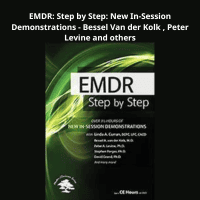Course Summary:
“EMDR: Step by Step: New In-Session Demonstrations” is a practical and comprehensive training program designed to guide therapists and clinicians through the effective implementation of Eye Movement Desensitization and Reprocessing (EMDR) therapy. Featuring new and insightful in-session demonstrations led by pioneers in trauma treatment, including Bessel van der Kolk and Peter Levine, this course provides a clear, step-by-step understanding of the EMDR protocol. Participants will gain valuable insights into each phase of EMDR, from client history and treatment planning to desensitization and installation, all illustrated through real-life therapeutic sessions. The course emphasizes practical application, allowing learners to observe experienced clinicians navigate the EMDR process with diverse client presentations.
Target Audience:
This program is ideal for:
- Therapists, psychologists, psychiatrists, counselors, and social workers.
- Mental health professionals seeking to learn or enhance their EMDR therapy skills.
- Clinicians working with individuals who have experienced trauma, PTSD, anxiety, and other related conditions.
- Students and trainees in mental health disciplines looking for practical EMDR training.
Main Content:
The course likely covers key areas such as:
- Introduction to EMDR Therapy: Overview of the history, theory, and principles of EMDR.
- The Eight Phases of EMDR Therapy: Detailed explanation and demonstration of each phase:
- Phase 1: Client History and Treatment Planning: Assessing client suitability and developing a treatment plan.
- Phase 2: Preparation: Establishing a safe and trusting therapeutic relationship and preparing the client for processing.
- Phase 3: Assessment: Identifying target memories and related feelings, cognitions, and body sensations.
- Phase 4: Desensitization: Processing target memories using bilateral stimulation (e.g., eye movements).
- Phase 5: Installation: Strengthening positive cognitions related to the target memory.
- Phase 6: Body Scan: Identifying and processing any residual physical sensations.
- Phase 7: Closure: Ensuring the client is stable at the end of the session and providing self-soothing techniques.
- Phase 8: Re-evaluation: Assessing treatment progress and planning future sessions.
- In-Session Demonstrations: Real-life examples of each EMDR phase with different client presentations.
- Adapting EMDR for Specific Populations and Issues: Considerations for using EMDR with diverse client groups and specific clinical challenges.
- Integrating EMDR with Other Therapeutic Approaches: Understanding how EMDR can be combined with other treatment modalities.
- Troubleshooting Common Challenges in EMDR Therapy: Addressing potential difficulties and learning effective solutions.
To provide a more precise summary, please provide the link to the sales page if you have it.
Master the EMDR protocol with expert in-session demonstrations!
SIGN UP NOW








